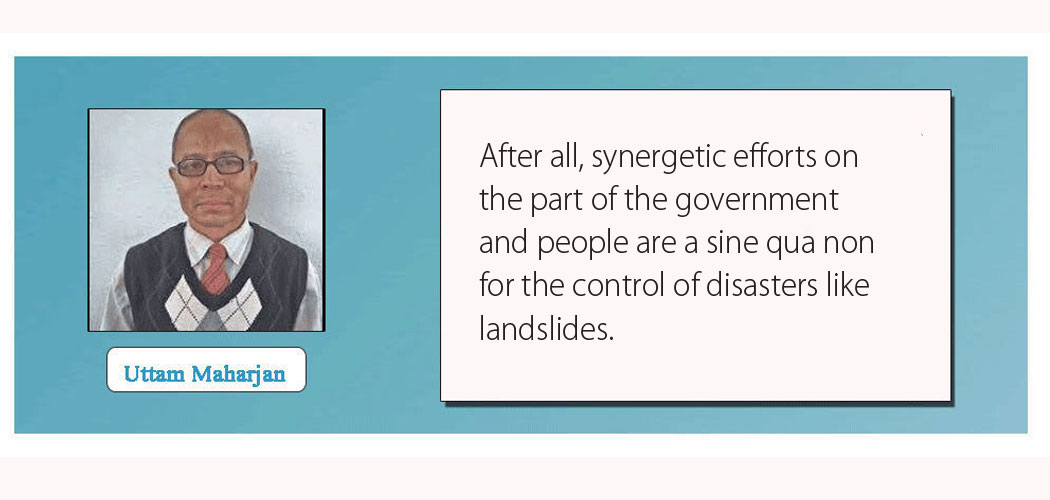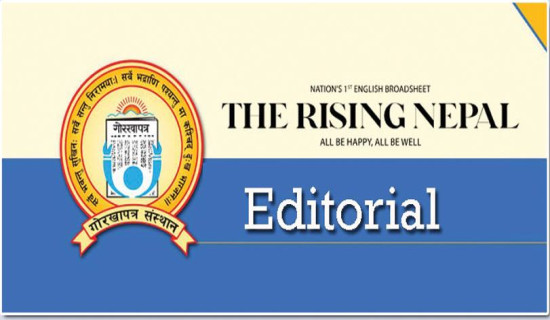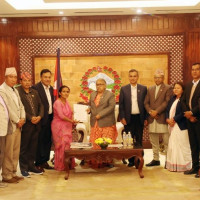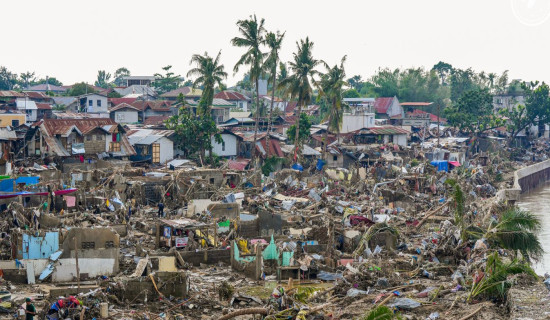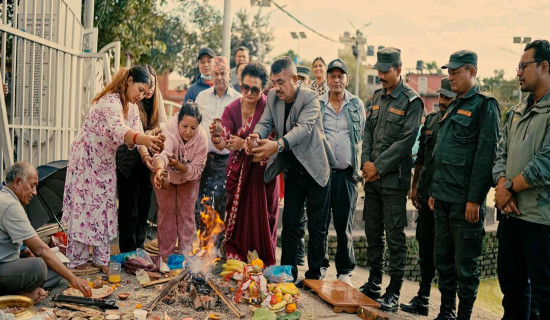- Tuesday, 11 November 2025
Engage Locals To Control Landslides
Landslides are among the formidable disasters in Nepal. In recent years, natural disasters, including landslides, have become more frequent. Natural and human factors cause landslides. The topography of the country consists of mountainous, hilly and plain regions. High mountains, Chure foothills and hilly midlands are vulnerable to slope failures, resulting in landslides. Hilly regions are prone to landslides owing to their fragile structure. During the monsoon season, the hilly regions become vulnerable to landslides. Steep slopes, soil erosion and runoff due to deforestation and other factors, unsound land management, and even climate change are contributory factors to landslides.
Monsoon rains increase disaster risks through floods and wet landslides. Recent records reveal that permafrost in high-altitude zones has melted owing to rising temperatures, intensifying the occurrence of rockfalls, avalanches and slope destabilisation. When the frozen ground warms owing to rising temperatures, the permafrost loses its capacity to hold rock and soil together, thus destabilising slopes. In fact, monsoon rains are becoming more erratic in South Asia, intensifying natural disasters like floods and landslides. In July 2025, a flash flood in the Bhotekoshi River swept away the Friendship Bridge, killing eight people, leaving dozens missing and destroying hundreds of vehicles. It was a colossal natural disaster.
Rising temperature
Climate change has contributed to rising temperatures, which have changed patterns of rainfall. At present, rainfall has been unpredictable. Some regions receive heavy rainfall, whereas others are gripped by a drought. Rising temperatures and changed patterns of rainfall have resulted in severe flooding and landslides. Rising temperatures have also led to excessive glacial melting. Glacial melting has increased the possibility of glacial lake outburst floods (GLOFs). In May 2025, a GLOF destroyed infrastructure and displaced 32 villages in Humla.
On the other hand, anthropogenic activities are also responsible for triggering landslides. People indulge in haphazard sand and gravel mining and clearing forested areas for settlement, which gives rise to soil erosion. Haphazard road construction without following safe engineering standards makes the earth fragile. The practice of constructing roads by digging hills with dozers has exacerbated the situation. It may be noted that the 2015 earthquake has made the ground and hills fragile. In hilly areas, Nepal’s roads are carved into unstable slopes. Such roads are often constructed without following geo-technological safety standards. Moreover, they are often left unpaved, making them vulnerable to soil erosion. Such roads are called non-engineered roads.
Besides wet landslides, dry landslides also occur in Nepal. Dry landslides indicate slope failures due to accumulated soil and rock without water content and are caused by haphazard construction work, natural slope instability due to steep terrain and fragile geology, and continuous movement of existing loose debris. In recent times, the occurrence of dry landslides has increased. Landslides have an adverse impact on life, property and daily activities. Disruption of transport due to landslides on highways leaves people and goods stranded. People cannot reach their destinations in time.
On the other hand, businessmen cannot receive their goods in time. Landslides damage or destroy infrastructure like roads and bridges and vehicles. They can also injure or take the lives of people. According to Nepal’s Disaster Risk Reduction Portal data, 4,629 landslides occurred in Nepal during the period from 2011 to August 2025, resulting in 1,906 deaths and 1,591 injuries. Infrastructure damage was put at Rs. 20.66 billion. The government has adopted anti-disaster measures. The Disaster Risk Reduction and Management Act is in place. The government seems to prioritise search and rescue operations over pre-disaster preparedness.
Plans need to be developed before the monsoon season sets in. Early warning systems need to be in place. Satellite data, ground sensors and communication networks can be used to make such systems reliable. This will enable the government to evacuate people living in disaster-prone areas to safety before it is too late. It should be kept in mind that Nepal could face a surge in disasters in the future. The government should, therefore, adopt more effective measures to control or mitigate disasters. A stitch in time saves nine.
For landslide control, it is imperative to update a detailed map of landslide-prone areas. Historical records of disasters, including landslides, also come in handy. Such records should be systematically compiled. Strategies should be formulated on the basis of the above. The government should also discourage people from living in high-risk areas. There is a tendency on the part of people to occupy and live in hilly areas without considering safety factors. This has put their life and property at stake.
Preparedness strategies
It is also necessary to formulate post-disaster preparedness strategies. There should be a robust provision of emergency responders. The Nepali Army is playing a pivotal role in post-disaster emergency response, which is praiseworthy. It is also necessary to enlist community engagement to respond to emergencies. Community people have indigenous knowledge of the local topography. The government should take strict measures to stop unregulated development works, beef up disaster infrastructure such as slope stabilisation and pay heed to constructing retaining walls and proper drainage systems. Establishing planned settlements, decreasing exposure to landslide areas and promoting green belt areas are other measures required for controlling landslides.
As stated above, community support is equally important in controlling landslides. So it will pay to sensitise people, especially those living in landslide-prone areas, to landslides and measures to be taken to control or minimise the impact of such disasters. They should be enabled to know alerts given by early warning systems. Training should be imparted to them on various aspects of disasters – pre-disaster, intra-disaster and post-disaster preparedness. This will help at least mitigate the consequences of disasters like landslides. After all, synergetic efforts on the part of the government and people are a sine qua non for the control of disasters like landslides.
(Maharjan has been regularly writing on contemporary issues for this daily since 2000.)

